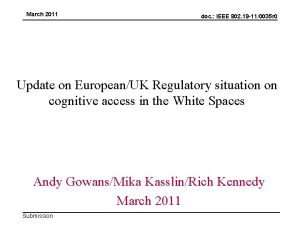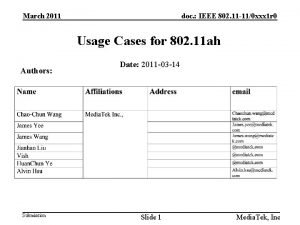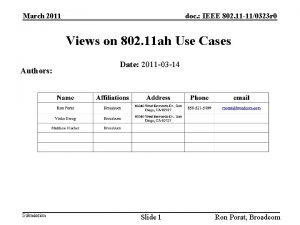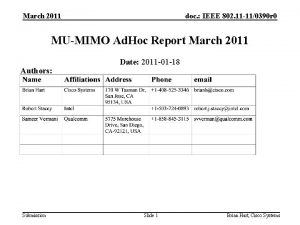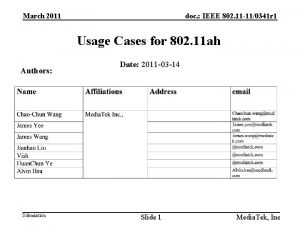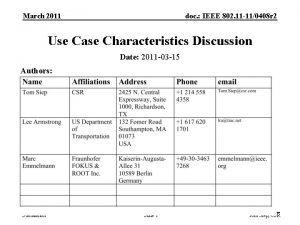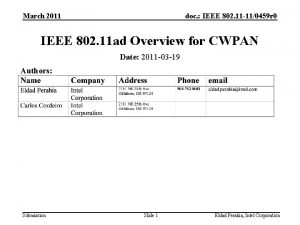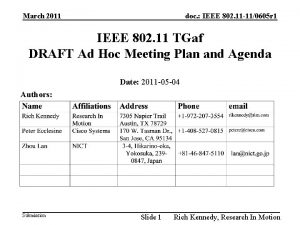March 17 2011 doc IEEE 802 15 11











- Slides: 11

March 17, 2011 doc. : IEEE 802. 15 -11 -0282 -00 -004 g Project: IEEE P 802. 15 Working Group for Wireless Personal Area Networks (WPANs) Submission Title: [Status Report LB 67 Receiver Interference Rejection Radio Specification Comments] Date Submitted: [17 March 2011] Source: [Dietmar Eggert 1, Steve Jillings 2, Jeritt Kent 3, Chuck Millett 3, Michael Schmidt 2] Company: [Atmel 1, Semtech 2, Analog Devices 3] E-Mail: [sjillings@semtech. com, Deitmar. Eggert@atmel. com, Michael. Schmidt@atmel. com, Jeritt. Kent@analog. com, Chuck. Millet@analog. com] Re: [] Abstract: [] Purpose: [To assist with comment resolution for LB #67 for MR-FSK Radio Specifications] Notice: This document has been prepared to assist the IEEE P 802. 15. It is offered as a basis for discussion and is not binding on the contributing individual(s) or organization(s). The material in this document is subject to change in form and content after further study. The contributor(s) reserve(s) the right to add, amend or withdraw material contained herein. Release: The contributor acknowledges and accepts that this contribution becomes the property of IEEE and may be made publicly available by P 802. 15. Submission 1 Steve Jillings, Semtech

March 17, 2011 doc. : IEEE 802. 15 -11 -0282 -00 -004 g CID #294, 435, 436 • COMMENTS – The above comments can be considered to be grouped relating to the ACR and AACR specification • REPORT – Attempt by the majority of silicon vendors supporting TG 4 g to move to a compromise consensus to resolve the receiver interference rejection specification to ensure INCLUSIVENESS for as many legacy systems as possible that operate in the frequency bands listed in Table 68 a which are required to support the CSM – To facilitate discussions and the resolution of a solution for the 2450 MHz band it was agreed that the radio specifications for the sub GHz bands defined in table 68 a are UNALTERED from the d 3 specification Submission 2 Steve Jillings, Semtech

March 17, 2011 doc. : IEEE 802. 15 -11 -0282 -00 -004 g CID #294, 435, 436 • REPORT – The silicon vendors explored several proposals which were felt to better reflect usage of the 2450 MHz band with respect to existing standards based specifications: • PROPOSED RESOLUTION – Accept in Principle – For the 2450 MHz band the receiver interference rejection shall be 0 d. Bm for the adjacent channel and 24 d. Bm for the alternate channel Submission 3 Steve Jillings, Semtech

March 17, 2011 doc. : IEEE 802. 15 -11 -0282 -00 -004 g CID #64 • COMMENT – Text incorrectly states that the intended interferer is to be unmodulated. This is not a reasonable test, devices will rarely have to reject unmodulated carriers in the real world • PROPOSED CHANGE – Correct text to match 802. 15. 4 i 6. 5. 3. 4 and the other two PHY's listed in this draft that state" In either the adjacent or the alternate channel, an IEEE 802. 15. 4 signal is input at the required min performance level" Submission 4 Steve Jillings, Semtech

March 17, 2011 doc. : IEEE 802. 15 -11 -0282 -00 -004 g CID #65 • COMMENT – Text has min ACR performance values of 10 and 30 for alternate and adjacent channels these numbers offer extremely minimal system performance and may result in multiple retry's to successfully deliver payloads • PROPOSED CHANGE – Change text to read a min of 30 db ACR is required in both adjacent and alternate channels Submission 5 Steve Jillings, Semtech

March 17, 2011 doc. : IEEE 802. 15 -11 -0282 -00 -004 g Receiver Jamming Resistance • GFSK BT = 1. 0 is MR-FSK Compliant Submission 6 Steve Jillings, Semtech

March 17, 2011 doc. : IEEE 802. 15 -11 -0282 -00 -004 g Receiver Jamming Resistance • “Filtered FSK” is also MR-FSK Compliant Submission 7 Steve Jillings, Semtech

March 17, 2011 doc. : IEEE 802. 15 -11 -0282 -00 -004 g Receiver Jamming Resistance • GFSK Adjacent Channel Interferer Submission 8 Steve Jillings, Semtech

March 17, 2011 doc. : IEEE 802. 15 -11 -0282 -00 -004 g Receiver Jamming Resistance • “Filtered FSK” Adjacent Channel Interferer Submission 9 Steve Jillings, Semtech

March 17, 2011 doc. : IEEE 802. 15 -11 -0282 -00 -004 g CID #64 • PROPOSED RESOLUTION – Reject – The test methodology for determining ACR and AACR has been discussed at length within the group and whilst other 15. 4 i PHYs have particularly well defined transmit spectral masks, this is not the case of the MR-FSK PHY, with the exception of the European and Japanese ISM bands, whereby regulatory limits will enforce more stringent spectral masks. – As the spectral mask of 15. 4 g is poorly defined, implementing the ACR / AACR test methodology currently specified allows for a simple comparison of receiver selectivity to be performed with respect to linear interfering mechanisms. – In addition, since spectral mask of 15. 4 g is badly defined, a Submission 10 Steve Jillings, Semtech

March 17, 2011 doc. : IEEE 802. 15 -11 -0282 -00 -004 g CID #65 • PROPOSED RESOLUTION – Reject – Spectral mask of 15. 4 g is poorly defined. A MR-FSK compliant signal could be at only -35 d. B below a wanted signal in the alternate channel. At an interference level of +30 d. B, the alternate channel signal may appear as a co-channel interferer of -5 d. B Submission 11 Steve Jillings, Semtech













